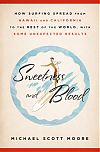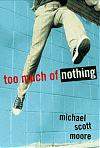The Economist ran a lead review of the book in 2010 and declared it a book of the year.
A brief interview at the New York Times ran in June 2010, and it’s reprinted below.
It accompanied Andy Martin’s fine piece in the NYT Book Review.
Mike took questions on the NPR show On Point in June 2010.
In August he was on the BBC show Americana, interviewed from his home surf break in California, and we very much wish we could find the podcast.
He gave an Inkwell interview some time later to the folks over at The Well.
There’s a three-minute Berlin Story up at NPR Berlin about Gregor Kollmar, a German surfer, and the beginnings of Sweetness and Blood.
… And there’s an interview about travel writing on World Hum.
An old slideshow about Munich’s unusual surf scene is up at The Atlantic Monthly — complete with a Beach Boys soundtrack in German!
This book trailer also made the rounds:

Stray Questions for: Michael Scott Moore
Michael Scott Moore’s book “Sweetness and Blood: How Surfing Spread From Hawaii and California to the Rest of the World, With Some Unexpected Results” is reviewed in this Sunday’s Book Review.
Q: How do you write in a literary mode about a subculture possibly best known for slang like “stoked” and “gnarly”?
A: Well, you avoid those words.
Just kidding. It’s simpler than that, because surfing has such an interesting history. The modern form of the sport happens to be a major American export, not unlike soccer for the British, and how it became a world activity is a majestic and very human story. I just set out to tell it. In retrospect, it’s shocking that no one beat me to it.
Surfing officially arrived in the U.S. in Redondo Beach, Calif., my hometown, in 1907. A man called George Freeth brought it over. I grew up knowing that. And for years I thought, So what? But after a little time in Berlin I realized there was a small hard core of German surfers. At first I thought, So what? My girlfriend at the time said I should write a book about surfing in strange places, like the standing wave in Munich.
But the idea didn’t catch fire until I wondered who the German George Freeth might have been. There had to be someone, either mythical or real. Well, the first German surfer, Uwe Drath, stood up on his rescue board as a lifeguard in about 1954. He still lives in Sylt, an island on the North Sea. So I got on a train to chat with him. And all the little kids he inspired, as this bare-backed freak in the freezing water in the ’50s, are old men now at the center of a very close-knit surf community on the island. They’re quite aware of their history. Drath got started two years before the generally accepted start of surfing in continental Europe, when Peter Viertel and some other Americans working on a Hemingway film in Biarritz conspired to bring a longboard over to France (in 1956).
So at the very least, I thought, I’ll have a book to annoy the French. And I thought it might work as a travel book. Not a literary-sounding travel book, but that’s precisely the point. Tim Cahill, one of the founders of Outside, just gave an interview about the heyday of that magazine. He said, “Our concept was that there’s a great strain in American literature of outdoor writing, from James Fenimore Cooper through Herman Melville through Mark Twain through Hemingway and Faulkner, and that we could continue that strain of literate outdoor writing. And at first, in 1976, we were made fun of, because it was thought by a lot of the critics, ‘Literate people don’t go outdoors.’ ”
Which is to say, a writer has to bust open the definition of “literary.” If he bows to it, he’s dead.
Q: What are you working on now?
A: Two novels. One is a series of linked stories set in my fictional surf town, Calaveras Beach. My first novel, “Too Much of Nothing,” was set there, and I want to revisit the neighborhood around the time of the Iraq war.
I also went to Africa late last year to write a series of articles about Somali pirates. A book about piracy has the same appeal to me as the surf book — it has the same clash between hard fact and clichéd mythology. It would also involve a great deal of travel.
Q: Describe a typical day in your writing life. What about your surfing life?
A: Not very interesting, but —
Writing: solid breakfast, then coffee at a messy desk. Pretty standard. If the weather stinks in Berlin, I may not leave the apartment. Right now half the week belongs to journalism, the other half to fiction.
Surfing: From Berlin you have to plan a surf trip like a ski trip. It’s unfortunate and unnatural. I like to surf Portugal and Morocco, when I can, and this winter I’ll have a reading in France. If I lived in California now my writing day might start with a surf session, which would make me less productive.
Q: What have you been reading or recommending lately?
A: I just read “Treasure Island” for the first time. It had me as rapt as a little boy. And I’m re-reading Melville, “Benito Cereno” and all the sailing stories. For some reason I have old ships on the brain. As for living writers, I was just telling people about “The Turning,” by Tim Winton, and “On a Wave,” by Thad Ziolkowski. Both excellent for different reasons. But I read them only after I finished the surf book. The writers I always come back to are Iris Murdoch, Derek Walcott, Faulkner, Bellow and Twain. Only one of them surfed, as far as I know.



